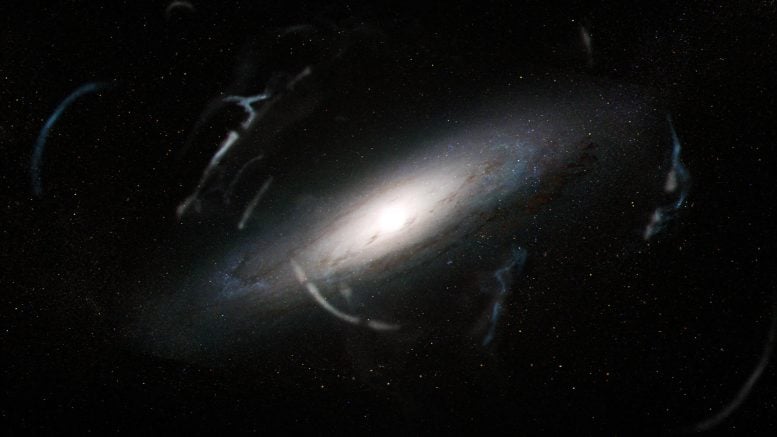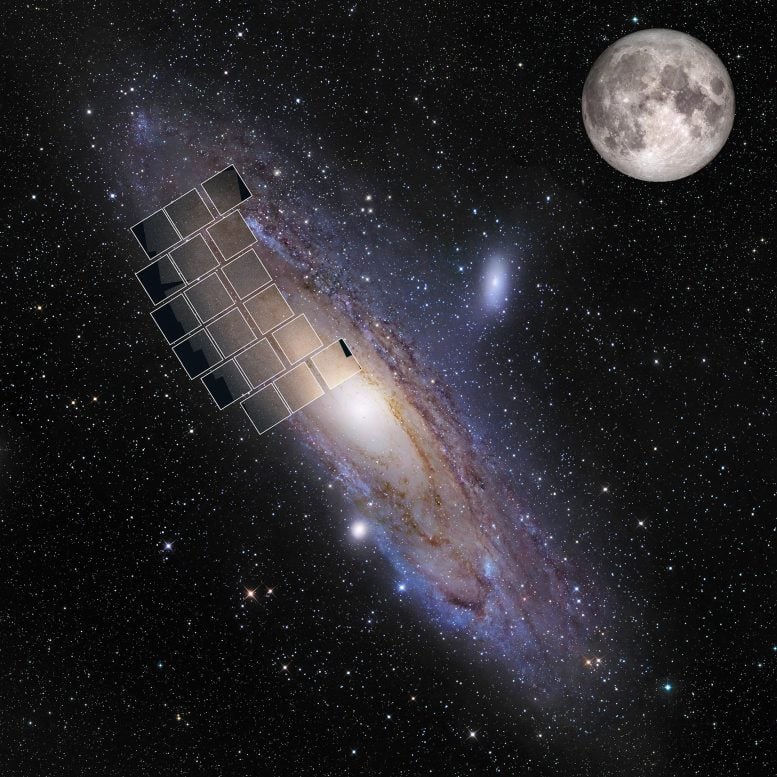Can NASA’s Roman Space Telescope Unlock the Secrets of Dark Matter?


Sometimes, stars can be stripped away from globular clusters as they orbit a massive galaxy. Researchers have identified several instances in our own Milky Way galaxy – and they’ve also spotted gaps between these looping tendrils. What caused those gaps? One possibility: a substance known as dark matter. Following the launch of the Nancy Grace Roman Space Telescope, astronomers will use its vast, high-definition images to spot many more tidal streams – and potentially their accompanying gaps – in nearby galaxies for the first time. A prime candidate is our neighbor, the Andromeda galaxy, which appears in the illustration above. Soon, not only will researchers be able to identify tidal streams in Andromeda, they may also be able to use Roman’s fine resolution to pinpoint more properties of this mysterious substance. Credit: NASA, Joseph Olmsted (STScI)
NASA’s Roman Space Telescope will use high-resolution imaging to study dark matter by analyzing star streams in the Andromeda galaxy, providing new insights into the cosmic role and properties of dark matter.
Some of the finest, smallest details in the universe – the gaps between elongated groups of stars – may soon help astronomers reveal dark matter in greater detail than ever before. After NASA’s Nancy Grace Roman Space Telescope launches, by May 2027, researchers will use its images to explore what exists between looping tendrils of stars that are pulled from globular clusters. Specifically, they will focus on the tidal streams from globular clusters that orbit our neighboring Andromeda galaxy. Their aim is to pinpoint a greater number of examples of these tidal streams, examine gaps between the stars, and ideally determine concrete properties of dark matter.
Globular cluster streams are like ribbons fluttering in the cosmos, both leading and trailing the globular clusters where they originated along their orbits. Their lengths in our Milky Way galaxy vary wildly. Very short stellar streams are relatively young, while those that completely wrap around a galaxy may be almost as old as the universe. A stream that is fully wrapped around the Andromeda galaxy could be more than 300,000 light-years long but less than 3,000 light-years wide.
Advanced Imaging and Observational Breakthroughs
With Roman, astronomers will be able to search nearby galaxies for globular cluster stellar streams for the first time. Roman’s Wide Field Instrument has 18 detectors that will produce images 200 times the size of the Hubble Space Telescope’s near-infrared camera – at a slightly greater resolution.

The vast footprint of the upcoming Nancy Grace Roman Space Telescope’s Wide Field Instrument shows how much its camera could observe in a single image. (The Wide Field Instrument has 18 square detectors.) Within this footprint is a simulated Roman image. The background is a ground-based image of the main disk of the Andromeda galaxy from the Digitized Sky Survey. A photo of the full Moon from NASA’s Lunar Reconnaissance Orbiter is provided for scale. Andromeda has a diameter of about 3 degrees on the sky, while the Moon is about 0.5 degrees across. (In reality, the Moon is much smaller than Andromeda, but it is also a lot closer.) The Wide Field Instrument’s footprint captures 0.28 square degrees of the sky in a single shot. Andromeda is a spiral galaxy that is similar in size and structure to our Milky Way galaxy, but is more massive. It is located approximately 2.5 million light-years from Earth. Credit: Image: NASA, NASA-GSFC, ASU, Robert Gendler DSS; Simulation: NASA, STScI, Benjamin F. Williams (UWashington)
“Roman will be able to take a huge snapshot of the Andromeda galaxy, which simply isn’t possible with any other telescope,” shared Christian Aganze, the lead author of a recent Astrophysical Journal paper about this subject and a postdoc at Stanford University in California. “We also project that Roman will be able to detect stars individually.”
Imagine the results: Roman’s vast, exquisitely detailed images will allow researchers to easily identify many examples of globular cluster streams in Andromeda. To date, astronomers using existing telescopes in space and on the ground have been limited to studying a slightly smaller number of globular cluster streams within our Milky Way.
Is Dark Matter Between the Stars?
Dark matter, which many assume to be a particle, can’t yet be observed directly, because it doesn’t emit, reflect, refract, or absorb light. If we can’t see it, how do we know it’s there? “We see dark matter’s effect on galaxies,” Aganze clarified. “For example, when we model how galaxies rotate, we need extra mass to explain their rotation. Dark matter may provide that missing mass.”
All galaxies, including the Milky Way, are surrounded by a dark matter halo. As astronomers glean more about the nature of dark matter, they may find evidence that a galaxy’s halo may also contain a large number of smaller dark matter sub-halos, which are predicted by models. “These halos are probably roughly spherical, but their density, sizes, and even if they exist isn’t currently known,” explained Tjitske Starkenburg, a co-author and a research assistant professor at Northwestern University in Evanston, Illinois.
The Future of Cosmic Research
Roman will redefine their search. “We expect dark matter to interact with globular cluster streams. If these sub-halos are present in other galaxies, we predict that we will see gaps in globular cluster streams that are likely caused by dark matter,” Starkenburg continued. “This will give us new information about dark matter, including which kinds of dark matter halos are present and what their masses are.”
Aganze and Starkenburg estimate that Roman will efficiently deliver the data they need within nearby galaxies – requiring only a total of one hour – and that these observations may be captured by the High Latitude Wide Area Survey.
Starkenburg will also help lay the groundwork for this investigation through her contributions to another project recently selected for funding by NASA’s Nancy Grace Roman Space Telescope Research and Support Participation Opportunities program. “This team plans to model how globular clusters form into stellar streams by developing a much more detailed theoretical framework,” she explained. “We’ll go on to predict where globular clusters that form streams originated and whether these streams will be observable with Roman.”
Aganze is also excited about other projects currently or soon coming online. “The European Space Agency’s Euclid mission is already starting to explore the large-scale structure of the universe, which will help us learn more about the role of dark matter,” he said. “And the Vera C. Rubin Observatory will soon scan the night sky repeatedly with similar goals. The data from these missions will be incredibly useful in constraining our simulations while we prepare for Roman.”
Reference: “Prospects for Detecting Gaps in Globular Cluster Stellar Streams in External Galaxies with the Nancy Grace Roman Space Telescope” by Christian Aganze, Sarah Pearson, Tjitske Starkenburg, Gabriella Contardo, Kathryn V. Johnston, Kiyan Tavangar, Adrian M. Price-Whelan and Adam J. Burgasser, 15 February 2024, The Astrophysical Journal.
DOI: 10.3847/1538-4357/ad159c
The Nancy Grace Roman Space Telescope, named in honor of NASA’s first chief astronomer and a pivotal figure in the development of the Hubble Space Telescope, represents a significant advance in space-based observatories. Scheduled for launch in the mid-2020s, this telescope is designed to explore a wide range of astronomical phenomena from the mysteries of dark energy and dark matter to exoplanet detection and infrared cosmic background exploration. Equipped with a 2.4-meter primary mirror and a suite of sophisticated instruments, including a Wide Field Instrument for large-scale surveys and a Coronagraph Instrument for directly imaging exoplanets, the Roman Space Telescope aims to conduct groundbreaking research over a vast swath of the sky with precision and depth unmatched by current observatories. Its mission is to extend our understanding of the universe, continuing the legacy of detailed astronomical inquiry and discovery.



